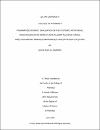Pharmacoeconomics Evaluation of the Systemic Antifungal Posaconazole for Prophylaxis against Invasive Fungal Infections among Immunocompromised Cancer Patients in Qatar
| المرشد | Al-Badriyeh, Daoud |
| المؤلف | Al-Marridi, Wafa Ziad |
| تاريخ الإتاحة | 2018-12-13T11:49:02Z |
| تاريخ النشر | 2018 |
| الملخص | The immunocompromised hematologic malignancy patients, at the National Center for Cancer Care (NCCCR) in Qatar, receive the antifungal posaconazole for prophylaxis as systemic prophylaxis against invasive fungal infections (IFIs). No economic evaluations of the prophylactic posaconazole in Qatar exist in literature, whether about the resource utilization associated with posaconazole as a stand-alone therapy, or the comparative economic impact of posaconazole against potential alternatives. The objective of this study was to evaluate the pharmacoeconomic impact of prophylactic posaconazole in hematologic malignancy patients at risk for IFIs in NCCCR, Qatar. Methods. Decision analytic economic models to perform a cost-analysis and a costeffectiveness analysis of posaconazole were constructed. The decision analytic models were from the hospital perspective, to follow the therapeutic pathways and consequences of systemic antifungals for prophylaxis, for a study duration of 112 days. The primary endpoint was a success with no major adverse drug reactions (ADR). Prophylaxis failure was defined by IFIs occurrence, death, and IFIs prevention but with major ADR. The costanalysis model was based the medical records available from 2013 to 2015, at NCCCR of the Hamad Medical Corporation (HMC), but was also complemented by data extracted from literature and local expert panels. The cost-effectiveness model was based on literature RCTs, which was adopted to the local setting by local expert panels and medical records data. Sensitivity analyses were conducted to enhance the robustness and generalizability of the results. Results. In the cost-analysis, 70 patients were eligible for the study inclusion. Therapy failure due to IFIs reached 43%, while death occurred in 7% of the patients, leading to successful prevention of IFIs in 50% of patients only. The primary outcome of IFI presentation without major ADR was achieved in 42.5% of patients. The average posaconazole utilization cost was QAR 109,802, with half of this consumed in failure due to IFIs. In the cost-effectiveness evaluation, similar success rate (IFI prevention without major ADR) was observed between posaconazole and fluconazole (0.76 versus 0.75, respectively), but with a significant Decremental Cost-Effectiveness Ratio (DCER) of QAR 3,922,618. The total therapy cost was higher with posaconazole (QAR 134,116 versus 80,463). The single patient pathway that influenced the outcomes of the models the most is the prevention of IFIs with having major ADR. Sensitivity analyses demonstrated the robustness of conclusions in both study models, with 96% chance for cost-savings to be in favor of fluconazole over posaconazole. Conclusion. The current study is the first economic evaluation of posaconazole in Qatar and the region, and the first in the literature to comprehensively follow up therapies throughout their IFIs failures and ADR. Prophylactic posaconazole was associated with a considerable cost to the NCCCR setting. This was considerably higher than that associated with fluconazole against IFIs in hematological patients, while being associated with a marginally minor improvement in outcome. This contradicts local Qatari practices in relation to only having posaconazole available for the prophylactic use in NCCCR. |
| اللغة | en |
| الموضوع | Cancer Qatar Evaluation |
| النوع | Master Thesis |
| التخصص | Pharmacy |
الملفات في هذه التسجيلة
هذه التسجيلة تظهر في المجموعات التالية
-
ماجستير في الصيدلة [65 items ]


